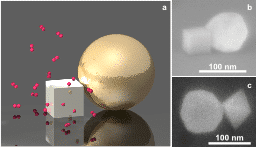
Plasmonic Nanospectroscopy of Hydride Formation Thermodynamics in Individual Single-Crystalline Pd Nanoparticles with Different Size and Shape
The size and shape of functional nanoparticles determines their physicochemical properties. Experimental investigations of size and shape effects are traditionally conducted on nanoparticle ensembles and are thus plagued by inhomogeneous sample material and averaging effects. These can be entirely eliminated by performing experiments on individual nanoparticles in situ. Here we present the first experimental study of the hydride formation thermodynamics in individual single-crystalline Pd nanoparticles of different size and shape, using non-invasive plasmonic nanospectroscopy.
We rely on wet-chemically synthesized Pd-Au heterodimers, created by electrostatic self-assembly of plasmonic Au nanoantennas and shape-selected Pd nanocrystals [1]. We probe the hydrogen sorption process by measuring the spectral shifts of the plasmonic scattering peak of individual dimers, which is proportional to the hydrogen concentration in the Pd particle. As the main result we find particle size and shape independent hydride formation enthalpy and entropy. We also observe hysteresis in the sharp hydrogenation/dehydrogenation phase transition that is significantly wider than in polycrystalline bulk systems. It is characterized by a shape-independent maximum width in the 30 – 40 nm particle size range. We explain these effects by the energetic interplay between dislocation formation and H-induced lattice strain at the coherent interface between a hydride shell and metallic core that governs the phase transition.
Finally, by means of FDTD simulations, we also elucidate the single particle plasmonic nanospectroscopy approach as such, to link the measured plasmonic signal to the fundamental processes in the Pd nanoparticle. Our results thus provide a generic blueprint for in situ studies of individual functional nanoparticles that can provide unprecedented insight into correlations between size and shape, and the targeted functionality.
[1] Gschneidtner, T. A.; et al. Langmuir 2014, 30, (11), 3041-3050

svetlana.syrenova@chalmers.se
Powered by Eventact EMS